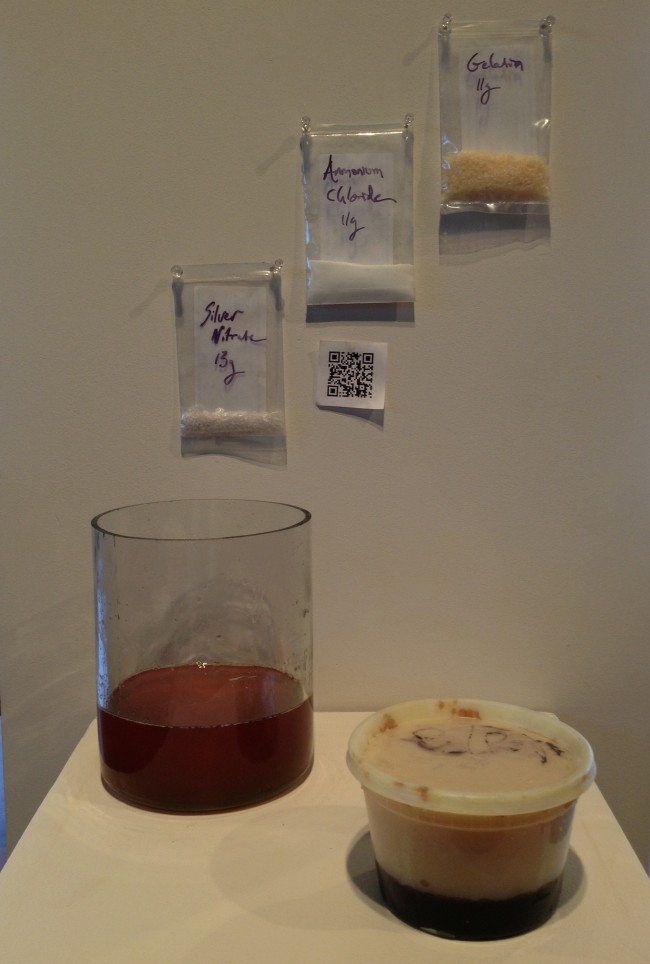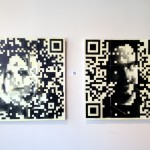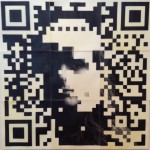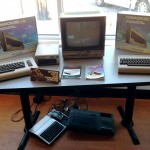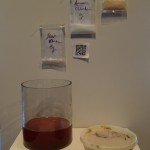Art, technology and innovation merge:
DISRUPTORS at the Artisan Enterprise Center
by Marla Sweitzer
Art and technology, innovation and entrepreneurship unite in DISRUPTORS, on display through May 24 at the Artisan Enterprise Center in Covington, Kentucky. The exhibit sets out to explore “the challenge of maintaining relevancy in art and technology and the role of the artist-innovator,” notes Curator Morgan Cobb.
Peiter Griga’s QRtifacts, which are portraits of local tech innovators overlaid with coding, are the focus of the show. Viewers are invited to break out their smartphones and interact (assuming they are technologically savvy and also have a QRReader – an application that scans and decodes square grids, transferring information. It was something I had to download). Cobb makes clear that “embracing innovation is not optional.” Without a smartphone the viewing experience is incomplete, as without a gadget to translate information, the viewer is reminded of how technology is outmoded.
Scattered grids of honey colored squares pattern the high contrast black and white portraits, the identity of the innovator somewhat obscured by the patterned codes. The parts of the portrait that peek through the grid remain in sharp focus in the center of the images, the features enclosed by the geometric grid. Some gazes, like that of Natalie Mathis of 3DKITBASH confront the viewer, while others look off into a distant space. From afar the images can appear systematically repetitive in the use of the code, though when viewing closer, each code is unique to the individual innovator.
Holding out the phone, a neon orange and red horizontal line vertically scans and decodes the puzzle overlaid on the portrait (or the smaller code next to the image if it is having trouble registering). The concealed grid of the image unveils a profile of the tech companies behind the portraits. The phone becomes a storytelling device, the viewer left with an imprint of the innovator’s tech startup on their personal gadget.
Featured within the profiles are the original black and white photograph of the innovator, shot in 35mm film, along with details of what the company does, their accomplishments, challenges and ultimately the impact they are trying to make. Here we begin to unfold the innovator’s identity, though it largely exists behind the company. Within these profiles, important questions are raised. How are moments preserved in an increasingly digital world? Some organizations like nugg-it are seeking to “bridge the online/offline divide in meaningful and positive ways.” Others, like 3DKITBASH aim to bring innovation to life, turning a product idea into reality.
Displayed on tables and elevated on pedestals, clunky computers and old keyboards from the Cincinnati Computer Cooperative juxtapose Griga’s work. A clear and noted nod to Marcel Duchamp’s ready-mades, these relics of technology’s past silently interact with us in a space where their functionality is obsolete. A Users Reference Guide to using a Texas Instruments computer rests closed on the floor beneath a classroom table, alongside three dated, disconnected and slightly ajar keyboards. Original boxed packaging is also on display on the table, the original contained elements also showcased. Once a new snazzy product, their dated bulkiness is now amusing, irrelevant, and perhaps even sad.
Though the computers don’t quite reach a level of aesthetic interest, their purpose appears to be conceptual. Cobb notes that this “juxtaposition of past and future technologies” serves to “evoke nostalgia and fuel possibility.” Once functional and innovative, these products are transformed from discarded products to elevated monuments, a reminder about innovation and relevancy. Tucked away on the walls of the side hallway are more of Griga’s portraits, devoid of overlaid codes. The light yellow beeswax and honey emulsion ingredients are brought to the forefront, without distraction. The sheets of wax gracefully lift off the wall, curving up, delicately, creating playful angular shadows on the wall. While the identity of the individual is concealed in a ghostly silhouette, the mystery of the images resonates. Less explicit and devoid of the coded algorithm, there is a beauty in a more quiet, less forced disruption.
In DISRUPTOTS, information can inundate. Manila envelopes, stuffed with digital reproductions of Griga’s portraits, are tacked up on the walls throughout the exhibit. Removing the contents and flipping through the pages, the reproductions go from original to faded copies – various interpretations of the same data. This data is less precious, more impersonal than the QRtifacts. Also taped on the walls in sporadic places are additional QR codes. Upon scanning, the codes lead to pages of a design team not featured by Griga, thereby adding their mark to the theme of disruption.
Along another wall, bits and snippets of segmented and typo-filled stories allude to the performance piece Ground Control to Major Tom: Analogue Silhouettes by creative duo Hark + Hark. The writing that was created by a typewriter is a form of stream of consciousness, void of spell check. Spacing of wording disrupts standard rules of writing. Traces of the process are seemingly more spur of the moment, and the preciousness of the paper is disregarded, ripped and presented in a more scattered and imperfect manner.
Furthering Griga’s aim to inform are documentations of the QRtifact process. A detailed 13-step guide to making a QRtifact (titled “The Fine Art of Execution”) spells out the process. A vase of the emulsion solution and plastic bags of silver nitrate, ammonium chloride and gelatin are tacked to a wall. Visual changes during the photo process are also documented. Printed on honey emulsion and dipped in hot unrefined beeswax, the portraits transform from an initial ghostly image with visible drippings of solution into a focused and relatively gunk-free final product. Traces of glue clumps and wax gloss that seal the square sheets that compose the portraits are visible in the large portraits.
At times DISRUPTORS overloads on information. Did I comprehend all the steps of the process to making the QRtifacts? Is it relevant that I know that nugg-it co-founder Mike served as a groomsman in Matthew’s wedding? In all the decoding, what do we retain? Griga writes, “Memories are the fuel we burn to stay alive. Whether those memories have any actual importance or not, it doesn’t matter as far as day-to-day activities are concerned. They’re all just fuel.” As is often the case with the information that informs our memories, there is a lot to sift through. Requiring the use applications that the viewer may not have runs the risk of alienation. Equipped with a smartphone, it is up to the viewer to interact, scan through the data, and decode.
Marla Sweitzer is a painter living in Covington, Kentucky.
- Peiter Griga – Natalie Mathis and Quincy Robinson 3DKITBASH Honey Emulsion 36″ x 36″
- Peiter Griga – Brinda Chatterjee MAKEUPHAULIC – Honey Emulsion 36″ x 36″
- Computer ready-mades
- Peiter Griga – David Rosenthal – Honey Emulsion 36″ x 36″
- Griga’s emulsion ingredients


